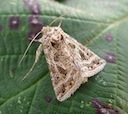 Mark Tunmore of Atropos discovered the migrant moth Thysanoplusia daubei (the Boathouse Gem) at Church Cove on the Lizard in 2014 – the first record for Britain!
Mark Tunmore of Atropos discovered the migrant moth Thysanoplusia daubei (the Boathouse Gem) at Church Cove on the Lizard in 2014 – the first record for Britain!
Photo: Mark Tunmore
Scientific name: Thysanoplusia daubei
Cornish name: ‘Gouwan’ is the general word for moth
What to look for:
- Family: Noctuidae.
- Colouring: Dark to reddish-brown forewings with distinctive white to pink markings and a pale band. Edge is serrated. Paler hind wings.
- Size: Wingspan 27 to 31 mm.
- Where: Originates from the Mediterranean coast eastwards to Turkey and North Africa, but sometimes seen elsewhere in Europe as an immigrant.
 Look what the wind blew in…Thysanoplusia daubei is a moth the usual range of which is the Mediterranean and North Africa, but which is sometimes found as an immigrant elsewhere in Europe. However, it has never been recorded as a migrant in Britain…until now.
Look what the wind blew in…Thysanoplusia daubei is a moth the usual range of which is the Mediterranean and North Africa, but which is sometimes found as an immigrant elsewhere in Europe. However, it has never been recorded as a migrant in Britain…until now.
The first record of this moth in Britain was made at Church Cove on the Lizard in November 2014 by Mark Tunmore of Atropos Publishing. It was blown here, along with a few other immigrant species, on autumn southerly winds, and landed in Mark’s moth trap – like many other nocturnal moth species, T. daubei is attracted to artificial illumination at night.
In their more southerly breeding range, the caterpillars eat the leaves of plants from the Mint and Dead Nettle (Lamiaceae) and Daisy (Asteraceae) families. There are usually two generations in its Mediterranean range, and several generations in Africa.
Did you know…?
…You can find up-to-date news about the arrival of migrant moths, butterflies and dragonflies, or you can post and share your own news and sightings, on Atropos’s website (the Flight Arrivals page).
Published: November 2014
Author: Amanda Scott
Photo: Mark Tunmore
